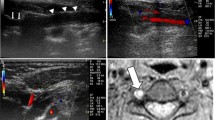Abstract
Purpose: To compare magnetic resonance angiography (MRA) with digital angiography for diagnosis of subclavian steal syndrome.
Methods: A comparison study between MRA and digital contrast arteriography was carried out in 10 patients with suspected subclavian steal syndrome. Two of these patients were studied by MRA before and after percutaneous transluminal angioplasty (PTA). MRA was obtained on a 1.5 tesla superconductive magnet with linear head coil using a fast low angle shot (FLASH 2D) sequence in the axial plane as well as a fast imaging with steady state precession (FISP 3D) with velocity compensation gradient echo sequence in the coronal plane. The coronal images were used as source data for the construction of projection images with the use of a maximum-intensity pixel algorithm. The images were rotated from -45° to 45° in 15° steps.
Results: All 10 patients had evidence of proximal subclavian artery obstruction and flow reversal in the ipsilateral vertebral artery. On MRA, consistent visualization of the affected vertebral artery in the FLASH 2D sequences and nonvisualization in the FISP 3D sequences was interpreted as an indirect sign of subclavian steal. The subclavian artery obstruction could not be assessed due to field size limits of MRA.
Conclusion: MRA allows determination of flow reversal in the diagnosis of subclavian steal
Similar content being viewed by others
References
Kajinami K, Mori K, Masuda S (1990; Asymptomatic congenital subclavian steal in a young male patient with right aortic arch. Chest 97:481–482
Ventura M, Speziale F. Taurino M, Petrassi C (1988) Insufficenza cerebro-vascolare. In: Delfino A (ed): Elementi di patologia e chirurgia vascolare. Delfino, Rome. pp. 378–383
Laglia P, Petrassi C, Pocek M, Maiolo F (1988) Diagnostica strumentale delle malattie vascolari. In: Delnno A (ed): Elementi di patologia e chirurgia vascolare. Delfino, Rome. pp. 72–74
Bendick PJ, Glower JL (1990) Hemodynamic evaluation of vertebral arteries by duplex ultrasound. Surg Clin North Am 70:235–244
Kotval P, Shah P, Berman M (1989) Doppler diagnosis of subclavian steal due to arteriovenous hemodialysis fistula in the ipsilateral arm. Ultrasound Med 8:697–700
Trattinig S, Hubsch P, Schuster M, Polzleitner D (1990) Colorcoded Doppler imaging of normal vertebral arteries. Stroke 21(8):1222–1225
Summer DS (1990) Use of color-flow imaging technique in carotid artery disease. Surg Clin North Am 70:201–211
Keiler P, Drayer B, Fram E, Williams KD, Doumoulin CL, Souza SP (1989) MR angiography with two-dimensional acquisition and three-dimensional display. Radiology 173:527–532
Edelman RR, Atkinson DJ, Silver MS, Loaiza FL, Warren WS (1988) FRODO pulse sequences: A new means of eliminating motion, flow, and wraparound artifacts. Radiology 166:231–236
Edelman RR, Wentz KU, Mattle MP, O’Reilly GV (1989) Intracranial arteriovenous malformations: Evaluation with selective MR angiography. Radiology 173:831–837
Sauter R, Requardt H, Weber H (1986) Magnetic resonance tomography using spacially designed RF antennas, Vol 54. In: Siemens (ed): Electromedica, Erlangen, pp 96–101
Mattle HP, Wentz KU. Edelman RR, Wallner B (1991) Cerebral venography with MR. Radiology 178:453–458
Masarik TS, Ross JS, Rugged PM, Laub GA, Heacke ME, Selman WR, Wiznitzer M, Hank JI (1989) Intracranial circulation: Preliminary clinical results with three-dimensional (volume) MR angiography. Radiology 171:793–799
Bonomo L, Carriero A (1992) Angiografia con risonanza magnetica. Radiol Med84:693–703
Pan X, Anderson C, Reilly L, Saloner D, Lee R (1992) Magnetic resonance angiography of the carotid artery combining twoand three-dimensional acquisition. J Vasc Surg 16:609–618
Brown D, Reiderer SJ (1992) Contrast to noise ratios in maximum intensity projection images. Magn Reson Med 23:130–137
Author information
Authors and Affiliations
Rights and permissions
About this article
Cite this article
Carriero, A., Salute, L., Tartaro, A. et al. The role of magnetic resonance angiography in the diagnosis of subclavian steal. Cardiovasc Intervent Radiol 18, 87–91 (1995). https://doi.org/10.1007/BF02807228
Issue Date:
DOI: https://doi.org/10.1007/BF02807228




